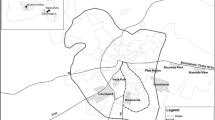Abstract
In Baltimore City, the relative well-being of black and white families using Section 8 housing vouchers versus Section 8 housing certificates is compared. Logistic regression is used to examine whether the social and economic characteristics of a regional planning district play a significantly different role in the likelihood that a district will have voucher or certificate recipients. A second analysis examines the average monthly rent paid by blacks and whites for housing in the certificate and voucher programs. The results suggest that whites receive greater economic benefits in the voucher program than in the certificate program while blacks do not.
Similar content being viewed by others
Notes
U.S. Bureau of the Census,1980 Census of Population and Housing, Census Tracts, PHC80-2-28, (July 1983), Baltimore MD, SMSA.
Claire Hammond,The Benefits of Subsidized Housing Programs, An Intertemporal Approach (Cambridge University Press, 1987).
Housing and Development Reporter, Vol. 18, No. 12 (August 6, 1990), p. 233.
This opinion is expressed by Lowry: The portability of housing allowances led some observers to speculate that a fullscale program would result in substantial spatial rearrangements of low-income households, particularly those belonging to racial minorities. Some thought that the program would help achieve a desirable pattern of residential integration, dispersing low-income and minority households among more prosperous white neighbor-hoods. Others worried that participants would abandon deteriorating neighborhoods.. . . Still others were skeptical that the program would much alter the residential distribution of participants. (Ira S. Lowry,Experimenting with Housing Allowances: The Final Report of the Housing Assistance Supply Experiment (Oelgeshclager, Gunn & Hain, Publishers, Inc., Cambridge, MA, 1983).
Abt Associates Inc.,Participation and Benefits in the Urban Section 8 Program: New Construction and Existing Housing, Vols. 1 and 2, Contract H-2902, Tasks 5 and 6 (1981).
The data is fromSection 8 Housing Programs, A Statistical Bulletin. Unpublished Statistics, Baltimore Public Housing Authority (August 18, 1988).
The data are from the U.S. Bureau of the Census,County and City Data Book, 1982 (A Statistical Abstract Supplement) (U.S. Government Printing Office: Washington, D.C., 1983.)
The data is fromSection 8 Housing Programs, A Statistical Bulletin, Unpublished Statistics, Baltimore Public Housing Authority (August 18, 1988).
Additional information
This article is based on a paper entitled /’’ The Impact of Housing Vouchers on the Black Family,” which was funded by the Baltimore Urban League and presented at the National Conference of Political Scientist, March 1989.
About this article
Cite this article
Ards, S. The role of housing vouchers in baltimore city, Maryland. Rev Black Polit Econ 19, 111–123 (1991). https://doi.org/10.1007/BF02895340
Issue Date:
DOI: https://doi.org/10.1007/BF02895340




